 Plant Summary
Plant Summary
Botanical Name: Dracaena marginata
Type: Foliage
Origin: Dracaena marginata originates from Madagascar.
Height: Kept indoors, the Madagascar Dragon Tree is capable of reaching heights of around 1.8 m (6 ft).
Soil: Any quality potting mix will be suitable for the Dragon Tree.
Light: While the Dragon Tree does like plenty of bright light, it needs to be kept out of direct summer sun.
Humidity: Dragon Tree's are happy in average humidity levels and will even tolerate fairly dry air.
 Temperatures: This plant is quite happy in an environment with temperatures between 16 and 24 degrees C (60 to 75 degrees F).
Temperatures: This plant is quite happy in an environment with temperatures between 16 and 24 degrees C (60 to 75 degrees F).
Water: During spring, summer and autumn, the plant's soil needs to be kept lightly moistened. In winter, it should be kept a little drier. It is vital to ensure the potting mix does not get waterlogged.
Fertiliser: A liquid 10-10-10 fertiliser should be diluted with water (50:50) and fed to the Dragon Tree on a fortnightly basis from spring through to the end of summer.
Propagation: The Dragon Tree's cane can be cut off at any desired height and rooted like any other stem tip cuttings.
 Description and Care Tips
Description and Care Tips
For homes with plenty of space, the Madagascar Dragon Tree offers itself as an easy to care for, bold accent plant. Starting out as just a tuft of a mass of spiky leaves, Dracaena marginata's lower leaves will drop off as it grows, leaving a partially bare woody stem with a cluster of spear-shaped, dramatic leaves - which are narrow, feature a red edge and can grow as long as 30 to 40 cm (12 to 16 in) - at the top.
This plant will thrive in average conditions, tolerating even dry air and low light if need be. It can even handle changes in humidity levels and temperatures quite well. While the Dragon Tree usually shrugs off the threat of pests, dry air may attract spider mites. Misting Dracaena marginata regularly will keep these little pests away and simultaneously raise humidity for the plant.
 The one thing Dragon Trees will not tolerate is soggy soil. Likely to cause root rot - a condition prone to kill off the plant - soggy soil should be avoided at all cost. Well draining soil and a pot with adequate drainage holes are essential to prevent over-watering Dracaena marginata.
The one thing Dragon Trees will not tolerate is soggy soil. Likely to cause root rot - a condition prone to kill off the plant - soggy soil should be avoided at all cost. Well draining soil and a pot with adequate drainage holes are essential to prevent over-watering Dracaena marginata.
Although this exotic house plant is rather slow-growing, it will eventually reach heights of up to 1.8 m (6 ft). The height this plant grows to can be controlled by simply cutting the top of the cane off at whichever height is suitable. It will grow a new leaf cluster from where the cut was made within a few weeks. The best time to do this is during the spring/ early summer months.




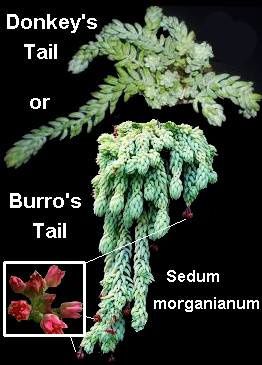 Plant Summary
Plant Summary  Temperatures: Ideal room temperatures for the Donkey's Tail should range between 18 and 24 degrees C (65 to 75 degrees F). To promote blooming, a cool winter rest with temperatures of 13 to 16 degrees C (55 to 65 degrees F) is recommended.
Temperatures: Ideal room temperatures for the Donkey's Tail should range between 18 and 24 degrees C (65 to 75 degrees F). To promote blooming, a cool winter rest with temperatures of 13 to 16 degrees C (55 to 65 degrees F) is recommended.  Description and Care Tips
Description and Care Tips  Repotting needs to be done in spring, but only when the plant has filled its pot. A shallow pot will be fine, as the Donkey's Tail's roots do not grow very deep, but it is essential to ensure the pot has drainage holes.
Repotting needs to be done in spring, but only when the plant has filled its pot. A shallow pot will be fine, as the Donkey's Tail's roots do not grow very deep, but it is essential to ensure the pot has drainage holes. 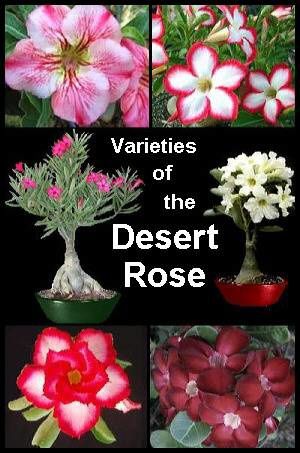 Plant Summary
Plant Summary  Temperatures: This species likes average room temperatures to range between 16 and 24 degrees C (60 to 75 degrees F).
Temperatures: This species likes average room temperatures to range between 16 and 24 degrees C (60 to 75 degrees F).  In summer, owners can expect an abundance of gorgeous red or pink flowers. Growing in clusters from the stems' tips, these flowers are a sight to behold for months, as the blooms will appear in succession.
In summer, owners can expect an abundance of gorgeous red or pink flowers. Growing in clusters from the stems' tips, these flowers are a sight to behold for months, as the blooms will appear in succession.  In winter, a lack of light, cold temperatures or dry soil may cause the Desert Rose to go dormant and drop its leaves. This is nothing to worry about - once the plant gets what it wants (light, water, warmth), the leaves will soon grow again.
In winter, a lack of light, cold temperatures or dry soil may cause the Desert Rose to go dormant and drop its leaves. This is nothing to worry about - once the plant gets what it wants (light, water, warmth), the leaves will soon grow again.  Plant Summary
Plant Summary  Temperatures: Being spring flowers, Daffodils like to be cool. Temperatures around 16 degrees C (60 degrees F) are optimal.
Temperatures: Being spring flowers, Daffodils like to be cool. Temperatures around 16 degrees C (60 degrees F) are optimal.  Unless the bulbs were purchased pre-chilled, the pot then needs to be stored in a cool - temperature should be between 4 and 7 degrees C (40 to 45 degrees F), not freezing - and dark place for 8 to 10 weeks. Regular checking to ensure the soil remains moist is essential throughout this period, which is known as the 'cold treatment' period. A refrigerator, unheated garage or basement will be perfect. Potential damage caused by the ethylene gas given off by ripening fruit/ vegetables needs to be avoided by keeping the pot well away from such fruit/ vegetables.
Unless the bulbs were purchased pre-chilled, the pot then needs to be stored in a cool - temperature should be between 4 and 7 degrees C (40 to 45 degrees F), not freezing - and dark place for 8 to 10 weeks. Regular checking to ensure the soil remains moist is essential throughout this period, which is known as the 'cold treatment' period. A refrigerator, unheated garage or basement will be perfect. Potential damage caused by the ethylene gas given off by ripening fruit/ vegetables needs to be avoided by keeping the pot well away from such fruit/ vegetables.  As far as varieties are concerned, there are plenty to choose from. Shades range from white and pink to cream, yellow or orange. The cup, often also referred to as the trumpet, may contrast in colour from the surrounding petals, some of which may be frilly. Some varieties offer double blooms or blooms with two colours, too.
As far as varieties are concerned, there are plenty to choose from. Shades range from white and pink to cream, yellow or orange. The cup, often also referred to as the trumpet, may contrast in colour from the surrounding petals, some of which may be frilly. Some varieties offer double blooms or blooms with two colours, too.  This list includes a selection of common, not quite so common and unusual house plants beginning with the letter 'C'. If the name of a plant is not known - sometimes well meaning friends remove details before giving a plant as a present because the price happens to be on the label - it may be possible to first of all identify it by taking a peek at the images shown in the
This list includes a selection of common, not quite so common and unusual house plants beginning with the letter 'C'. If the name of a plant is not known - sometimes well meaning friends remove details before giving a plant as a present because the price happens to be on the label - it may be possible to first of all identify it by taking a peek at the images shown in the 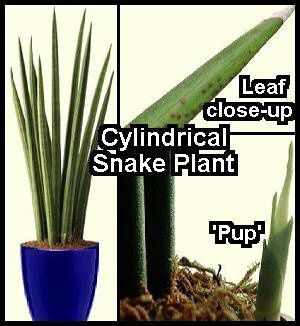 Plant Summary
Plant Summary  Humidity: Average humidity levels are required for the Cylindrical Snake Plant, although it will tolerate dry air to a certain extent. It should, however, be kept well away from drafts and/ or air vents.
Humidity: Average humidity levels are required for the Cylindrical Snake Plant, although it will tolerate dry air to a certain extent. It should, however, be kept well away from drafts and/ or air vents.  Propagation: Like all Snake Plants, this species can be propagated by separating its offsets - known as pups - growing from the parent's base. Dividing this plant is easy enough: after turning the pot onto its side, the plant is eased out carefully. The pups can then be cut off the parent plant using a sharp, serrated knife and planted into their own containers.
Propagation: Like all Snake Plants, this species can be propagated by separating its offsets - known as pups - growing from the parent's base. Dividing this plant is easy enough: after turning the pot onto its side, the plant is eased out carefully. The pups can then be cut off the parent plant using a sharp, serrated knife and planted into their own containers.  Related to the Mother-in-Law's Tongue - and just as carefree and easy to grow - this plant has a bold, fresh style that will add a striking accent to a collection of house plants. Because Sansevieria cylindrical is so easy going and highly tolerant of both dry air and dry soil, it lends itself perfectly as an office plant.
Related to the Mother-in-Law's Tongue - and just as carefree and easy to grow - this plant has a bold, fresh style that will add a striking accent to a collection of house plants. Because Sansevieria cylindrical is so easy going and highly tolerant of both dry air and dry soil, it lends itself perfectly as an office plant.  Plant Summary
Plant Summary  Description and Care Tips
Description and Care Tips  Poor ventilation and wet soil may encourage the growth of a fuzzy, grey fungus called botrytis. This fungus is capable of very quickly killing off the plant. Affected leaves therefore need to be removed as soon as the first signs of an infection - brown patches on yellowing leaves - appear. Plants that are very badly affected may need to be discarded completely.
Poor ventilation and wet soil may encourage the growth of a fuzzy, grey fungus called botrytis. This fungus is capable of very quickly killing off the plant. Affected leaves therefore need to be removed as soon as the first signs of an infection - brown patches on yellowing leaves - appear. Plants that are very badly affected may need to be discarded completely. 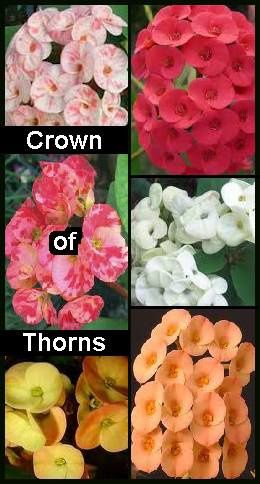 Plant Summary
Plant Summary  Water: The top 2.5 cm (1 in) of the potting mix should be allowed to dry out between watering sessions. To prevent this house plant from rotting, it is important to avoid getting its stems and leaves wet. During the plant's resting period in the winter months, watering should be reduced to a bare minimum.
Water: The top 2.5 cm (1 in) of the potting mix should be allowed to dry out between watering sessions. To prevent this house plant from rotting, it is important to avoid getting its stems and leaves wet. During the plant's resting period in the winter months, watering should be reduced to a bare minimum.  Description and Care Tips
Description and Care Tips  Easy to grow and comparatively drought tolerant, these house plants prefer to live in sandy, slightly dry soil. Because they store water within their thick stems, they do not need to be watered as often as other house plants. Watering should be reduced if the leaves begin to turn yellow and/ or fall off.
Easy to grow and comparatively drought tolerant, these house plants prefer to live in sandy, slightly dry soil. Because they store water within their thick stems, they do not need to be watered as often as other house plants. Watering should be reduced if the leaves begin to turn yellow and/ or fall off. 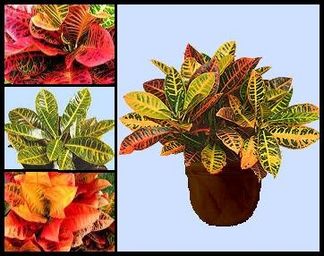 Plant Summary
Plant Summary  Temperatures: Crotons like to be kept reasonably warm. Temperatures ranging from 18 to 29 degrees C (65 to 85 degrees F) are ideal.
Temperatures: Crotons like to be kept reasonably warm. Temperatures ranging from 18 to 29 degrees C (65 to 85 degrees F) are ideal.  Description and Care Tips
Description and Care Tips  Until the Croton gets to the desired size, it should be repotted in spring, moving up just one container size at the time. Once it has grown to the right size, it can be kept from growing larger by keeping it in the same container and just top dressing it once a year.
Until the Croton gets to the desired size, it should be repotted in spring, moving up just one container size at the time. Once it has grown to the right size, it can be kept from growing larger by keeping it in the same container and just top dressing it once a year.